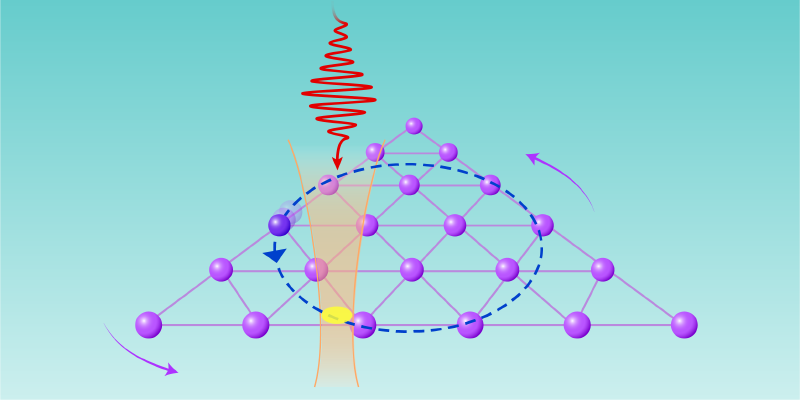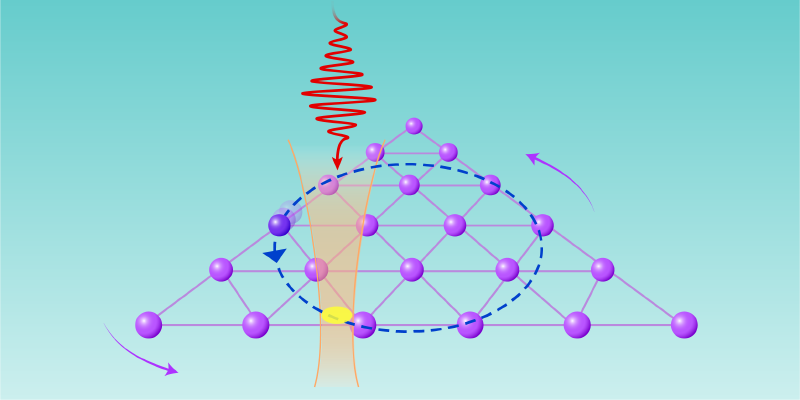Qubits Manipulated on the Fly
Simulating quantum many-body physics could be one of the main applications of a general-purpose quantum computer. But such a computer is not yet available, and so there is strong interest in constructing so-called analog quantum simulators. These are engineered systems of particles that can be used to investigate specific many-body problems. The experimental challenge is to increase the number of particles in such a simulator while retaining the ability to control the system at the single-particle level. Now Brian McMahon and colleagues at the Georgia Institute of Technology have demonstrated how this challenge can be overcome for one of the most promising types of analog quantum simulators that use ions held in devices known as Penning traps [1].
In a Penning trap, a charged particle is confined along one direction by a static quadrupole electric field. The same field, however, pushes the particle away from the trap’s center in the plane perpendicular to the confining axis. To counteract that effect, a strong homogeneous magnetic field is added to the trap, causing the particle to orbit the trap’s center in this plane.
When many ions are loaded into the trap, they form a non-neutral plasma. If this plasma is laser cooled to temperatures below 10 mK, it can become crystalline, with the equilibrium positions of the ions determined by the interplay of the confining forces and the ions’ mutual repulsion. However, the magnetic force makes the ion crystal rotate tens of thousands of times per second. This rotational frequency can be controlled by adding a rotating quadrupole electric field, which exerts a torque on the plasma [2]. More importantly, this “rotating wall” technique can synchronize the orientations of the ion crystal and the applied field [3]. This synchronization allows scientists to track the positions of the ions in the rotating reference frame of the field and to take fluorescence images of the crystal [4].
Planar ion crystals in Penning traps are useful systems for investigating many-body problems in quantum magnetism, such as the behavior of spins arranged on a 2D lattice and interacting over long distances. The “spin” that the ions carry is not an intrinsic spin (such as that of an electron); rather, each ion acts as a qubit with a pair of electronic states that can represent spin up and spin down. These qubits can be measured by detecting their state-dependent fluorescence ion by ion [5].
To realize long-range qubit–qubit interactions, the ion crystal can be illuminated by laser light to create state-dependent forces mediated by the crystal’s collective motion [6]. This method has been applied to crystals of more than 200 ions to produce so-called spin-squeezed states, quantum states that can be measured with greater precision than regular states [7]. However, the control here is over the collective state of all the ions. To study specific spin interactions, scientists would like to manipulate individual ions, but they have lacked this ability because the laser light typically targets many ions and because it is difficult to address such rapidly rotating particles.
McMahon and colleagues have now demonstrated this ability. The researchers constructed a compact Penning trap out of two permanent magnets and two printed circuit boards each patterned into 12 electrodes. The magnets created a strong magnetic field of about 1 tesla, and voltages applied to the electrodes produced a time-dependent trapping field. A key innovation was to replace the standard quadrupole rotating wall with a triangular one, in which ions can form planar crystals with a defect-free triangular-lattice structure. This setup avoids the problem faced in conventional trapping fields where increased ion spacing toward the crystal’s border leads to multiple possible crystal structures, which can introduce defects [8]. With these advances, the team succeeded in creating triangular lattices of more than 100 ions.
McMahon and colleagues chose to work with singly charged calcium ions. Each of these ions has a metastable electronic energy level that can be split via a magnetic field into multiple states, two of which can be used to encode a qubit. The researchers manipulated such qubits collectively using microwave radiation and measured them individually using a fast single-photon-counting camera.
To perform single-qubit operations, McMahon and colleagues focused a laser beam onto the ion crystal from a direction perpendicular to the crystal plane, such that the beam’s spot was smaller than the ion spacing (Fig. 1). The researchers could then optically address individual ions by switching on the beam just before the selected ion passed through it. The interaction between the beam and the ion slightly altered the energy difference between the qubit’s two states. Using this effect, the team manipulated different ions while maintaining quantum coherence and investigated the effect of various physical parameters on the quality of the single-qubit operation, concluding that it could be applied to crystals of 1000 ions. Such a large increase in ion number would allow scientists to conduct simulations of complex quantum many-body physics in and out of equilibrium.
More work will be needed to improve the quality of the quantum operations. First and foremost, the ion motion in the crystal plane will have to be reduced using advanced laser-cooling techniques to limit unwanted fluctuations in the strength of the beam–ion coupling, and further technical improvements to the setup will need to be made. This work by McMahon and colleagues, in conjunction with recent advances in building microscale Penning-trap arrays [9], shows that Penning traps are powerful tools for precisely controlling ions in quantum physics experiments. Parallel progress in creating large planar ion crystals in radio-frequency traps [10] demonstrates the potential of trapped-ion experiments for investigating spin systems using hundreds of particles.
References
- B. J. McMahon et al., “Individual-ion addressing and readout in a Penning trap,” Phys. Rev. Lett. 133, 173201 (2024).
- X.-P. Huang et al., “Steady-state confinement of non-neutral plasmas by rotating electric fields,” Phys. Rev. Lett. 78, 875 (1997).
- X.-P. Huang et al., “Phase-locked rotation of crystallized non-neutral plasmas by rotating electric fields,” Phys. Rev. Lett. 80, 73 (1998).
- T. B. Mitchell et al., “Direct observations of structural phase transitions in planar crystallized ion plasmas,” Science 282, 1290 (1998).
- R. N. Wolf et al., “Efficient site-resolved imaging and spin-state detection in dynamic two-dimensional ion crystals,” Phys. Rev. Appl. 21, 054067 (2024).
- J. W. Britton et al., “Engineered two-dimensional Ising interactions in a trapped-ion quantum simulator with hundreds of spins,” Nature 484, 489 (2012).
- J. G. Bohnet et al., “Quantum spin dynamics and entanglement generation with hundreds of trapped ions,” Science 352, 1297 (2016).
- D. Kiesenhofer et al., “Controlling two-dimensional Coulomb crystals of more than 100 ions in a monolithic radio-frequency trap,” PRX Quantum 4, 020317 (2023).
- S. Jain et al., “Penning micro-trap for quantum computing,” Nature 627, 510 (2024).
- S.-A. Guo et al., “A site-resolved two-dimensional quantum simulator with hundreds of trapped ions,” Nature 630, 613 (2024).





